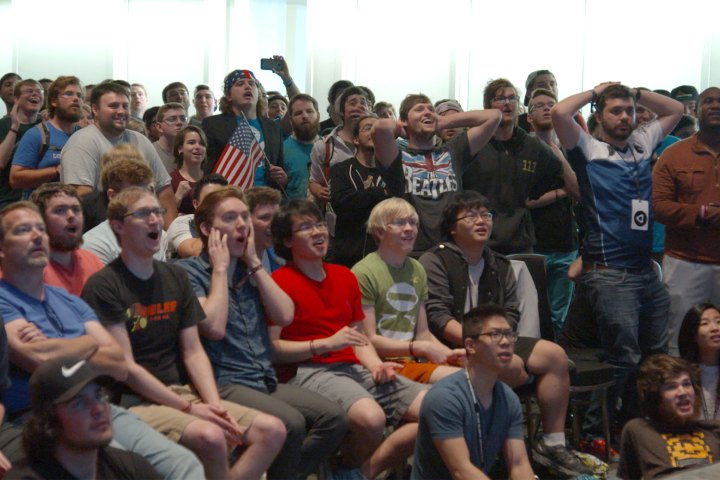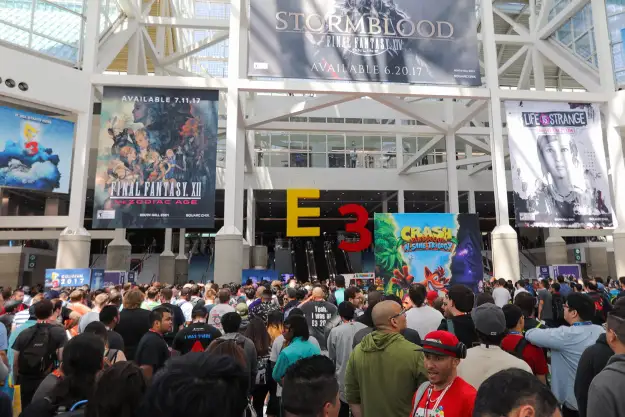
Esports, or professional competitive video gaming, has surged in popularity in the past few years. Tales of distant Korean arenas packed with fans have now become reality stateside. Passionate fans have grown, forging alliances with their favorite players and teams that do battle on the digital field. It’s the same type of atmosphere you would find at a traditional sporting event, except with more cosplay.
As esports continue to grow, more teams, players, and sponsors are jumping in to get their piece of the pie. Looking at the numbers, it’s obvious: Market researchers at Newzoo expect the industry to grow to $1.1 billion by 2019. That’s probably why the likes of Shaquille O’Neal, HTC, and Monster Energy all now have some kind of vested interested in esports.
But what’s so compelling about watching people play video games? Why is esports a big deal?
Digital Trends caught up with industry members to gain a better understanding of the esports boom.
As esports continue to grow, more teams, players, and sponsors are jumping in to get their piece of the pie.
Critics often scoff at esports being called “sports.” Even industry insiders agree that there’s a perceptual challenge that people have to initially get over. Many are quick to judge and dismiss competitive video gaming as being the same realm as traditional sports. For example, former ESPN pundit Colin Cowherd went on an on-air tirade after the network broadcast a Heroes of the Storm tournament.
Part of that perceptual challenge comes by the very nature of non-physical competition. It’s something that Panda Global’s Robert “Wobbles” Wright has had to explain before. He’s a competitive Super Smash Bros. Melee player from Texas, and is considered one of the best in the world. “When you compete in anything, you’re trying to drive it up to a higher level” said Wright. “When you see someone do something amazing in [a game] it makes you want to boot it up and try it. Only then can you ‘appreciate the difficulty of the game.’”
Wright is no stranger to traditional sports, and in in the heat of competition, he says esports aren’t too far off. “I remember thinking back on soccer games I could have won… the things I messed up, or things I did well in ways I saw the path to victory… when I think back on my favorite competitive moments in games, it is in a lot of ways the exact same feeling.”
Of course Wright has had to deal with his share of naysayers, who fail to appreciate the complexities of competitive play. “I think a lot of [criticism] does come from people who don’t know how hard these games can get when you try really playing consistently at a high level” said Wright. “It doesn’t look like it, especially not when you’re watching the person sitting there, but snap judgements, strategy, quick decision making, fine motor control under pressure, is really hard.” Top players, he says, have mere 60ths of a second to decide the fate of a competition by margins of just pixels, while maintaining focus and outthinking someone else. “It’s tough stuff.”
When watching a high-level competition, it’s easy to see that not everyone is capable to pulling off such digital feats, and that’s precisely why esports have taken off. People have been crowding around arcade cabinets of Donkey Kong and Pac-Man for years, but only recently has high level gaming become a legitimate career path. Team Liquid’s player manager Brittany Lattanzio has some theories as to why. “The people who played it like 10 years ago ㅡ played professional games ㅡ are grown up and have kids” said Lattanzio. It’s many in this older generation that see the potential and are investing time and capital; they in-turn have made it acceptable to play games.
To an outsider, the idea of a major car brand putting money into a group of gamers can seem a bit odd.
Clearly it’s paying off; many major brands are sponsoring teams. “Nissan, for example, sponsors us,” said Lattanzio because “our demographic is becoming older, and they’re in the age where they are looking to buy cars, so it’s a good target for them.”
To an outsider, the idea of a major car brand putting money into a group of gamers can seem a bit odd. How can Team Liquid be compared to the Dallas Cowboys? “Traditional athletes have like teams and managers, it’s sort of analogous” said Lattanzio. It requires taking “care of the players and make[ing] sure they have all the stuff they need so they can go perform.”
Nissan isn’t the only company jumping on board; insurance company Geico now supports two top teams. “Geico saw a really cool opportunity to support this budding esports excitement” explains John Hafkin of Geico Gaming. Although its logo gets plastered all over major pro gaming events, Geico also understands that simply throwing your name on a team isn’t enough: “We’re taking the time to learn about the community and not come in and do anything other than support what’s going on,” Hafkin says. For instance, Geico hosts amateur tournaments for Hearthstone, and plans to support other games in the future.
Hafkin did admit he couldn’t entirely wrap his mind around esports until he attended his first match. “I think you really understand esports at a level that other people don’t when you go to a live event,” he says. In the same way a kid may not fully appreciate the game of football until they go to an NFL game, the gravitas of esports doesn’t always settle until you’ve seen it in the flesh. “The production values are incredibly high, the crowd is super energetic.”
Jimmy Kimmel caught the ire of many online for making fun of people who watch other people play video games. He found it a step removed: it’s not like watching basketball, but watching someone watching basketball. That’s still a mainstream sentiment, and it may be for some time. But considering the crowds and excitement at recent events like DreamHack Austin, there’s clearly a lot more to it than that.
Competing at an incredibly high level and pulling off complex digital feats within fractions of a second with screaming crowds and money on the line is not easy. Esports may seem foreign to a lot of people, but the underlying themes of competition are there. And as long as people are willing to watch, the scene will only continue to grow.
Editors' Recommendations
- How an underdog Street Fighter 6 player beat the odds to win $1 million
- Killer Klowns from Outer Space: The Game keeps the cult film’s zaniness intact
- 2023 gaming report card: how did PlayStation, Xbox, and Nintendo score?
- A busy 2023 wasn’t enough to pull me away from my go-to mobile game
- Steam Year in Review 2023 is live — here’s how to see your Steam Replay



